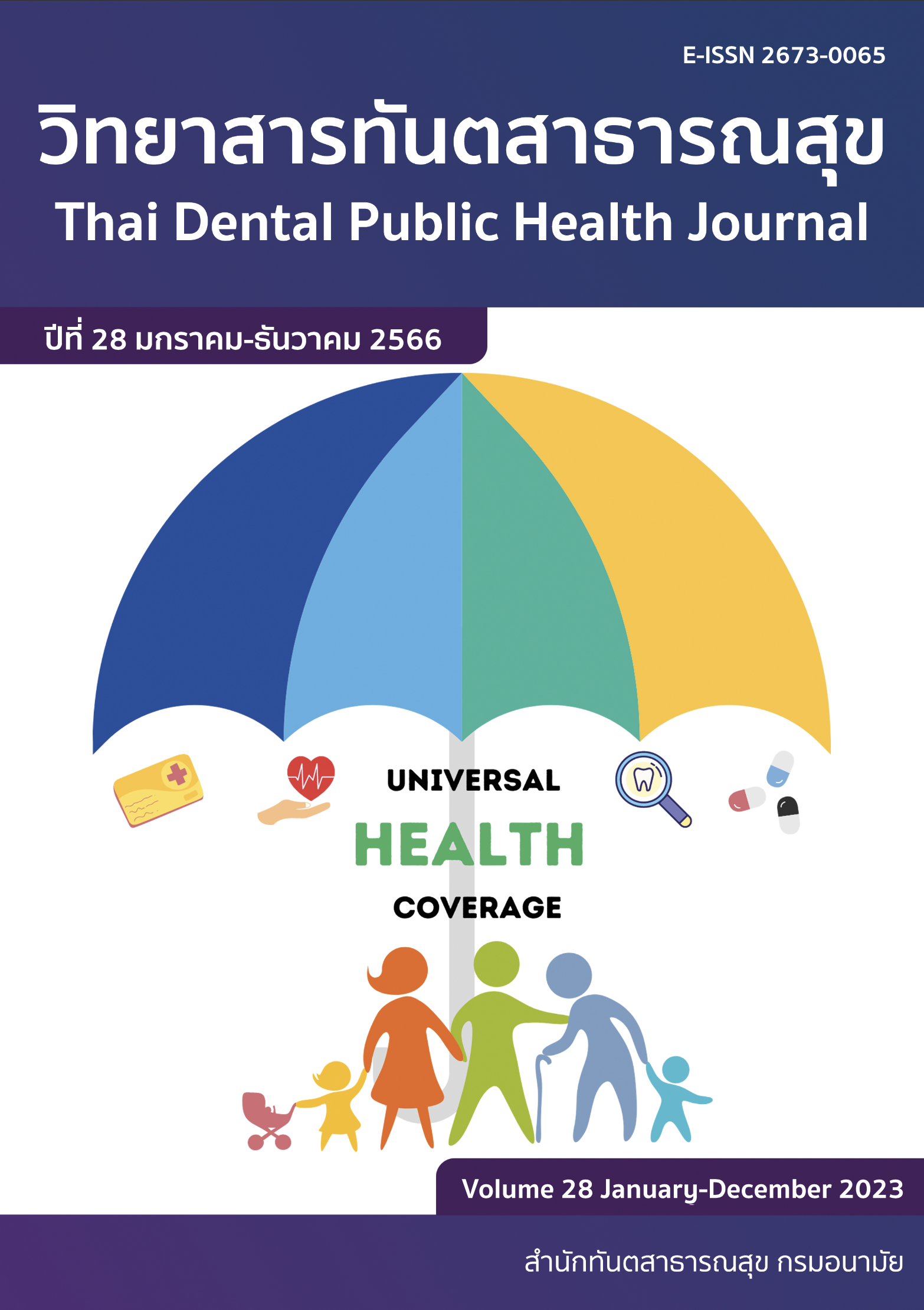The comparison of caries detection agreement between smartphone imaging and visual examination in primary school students
Main Article Content
Abstract
This study aimed to compare caries detection agreement between smartphone imaging and visual examination using the International Caries Detection and Assessment System (ICDAS). Sixty-two primary school students (86.1% of the student population), aged 6 to 12 years, were recruited for the study. One experienced dentist performed the visual examination by clinically assessing the lower first permanent molars and upper anterior permanent incisors and then examined blinded and randomly intra-oral photographs from a smartphone on the computer screen. The weighted kappa, sensitivity, specificity, and percentage of error were analyzed. The weighted kappa of caries detection between smartphone photographs and visual examination was 1.0 for anterior and 0.8 for posterior teeth, showing high agreement in caries detection. There was no misdiagnosis for severe caries of the ICDAS-5 and 6. Nevertheless, errors at a percentage lower than 50% were found when differentiating the diagnosis of initial caries at ICDAS-2, 3, or 4 lesions in dentin. The most visualized surfaces, the occlusal surface of lower molars and the labial surface of upper incisors, showed higher sensitivity (96.8% and 100%, respectively) than specificity (95.9% and 99.4%, respectively) for caries detection. In contrast, the buccal surface of molars had higher specificity (86.4%) than sensitivity (75.0%). These findings suggested that when one examiner performed caries detection in permanent lower molars and upper incisors using smartphone intra-oral photographs was accurate compared to visual examination. Smartphone photography might be an alternative tool for caries assessment in permanent teeth, especially in deprived areas.
Downloads
Article Details

This work is licensed under a Creative Commons Attribution-NonCommercial-NoDerivatives 4.0 International License.
References
Akinyamoju CA, Dairo DM, Adeoye IA, Akinyamoju AO. Dental caries and oral hygiene status: survey of schoolchildren in rural communities, Southwest Nigeria. Niger Postgrad Med J 2018; 25(4): 239-45.
Northridge ME, Kumar A, Kaur R. Disparities in access to oral health care. Annu Rev Public Health 2020; 41: 513-35.
Peres MA, Macpherson LMD, Weyant RJ, Daly B, Venturelli R, Mathur MR, et al. Oral diseases: a global public health challenge. Lancet 2019; 394(10194): 249-60.
Bureau of Dental Health. The 8th national oral health survey 2017 of Thailand. Bangkok: Department of Health; 2018. (in Thai)
Cheng L, Zhang L, Yue L, Ling J, Fan M, Yang D, et al. Expert consensus on dental caries management. Int J Oral Sci 2022; 14(1): 1-8. doi:org/10.1038/s41368-022-00167-3.
Ismail AI, Sohn W, Tellez M, Amaya A, Sen A, Hasson H, et al. The International Caries Detection and Assessment System (ICDAS): an integrated system for measuring dental caries. Community Dent Oral Epidemiol 2007; 35(3): 170-8.
Boye U, Walsh T, Pretty IA, Tickle M. Comparison of photographic and visual assessment of occlusal caries with histology as the reference standard. BMC Oral Health 2012; 12: 1-7. doi:10.1186/1472-6831-12-10.
Estai M, Winters J, Kanagasingam Y, Shiikha J, Checker H, Kruger E, et al. Validity and reliability of remote dental screening by different oral health professionals using a store-and-forward telehealth model. Br Dent J 2016; 221(7): 411-14.
Park JS, Kruger E, Nicholls W, Estai M, Winters J, Tennant M. Comparing the outcomes of gold-standard dental examinations with photographic screening by mid-level dental providers. Clin Oral Investig 2019; 23(5): 2383-7.
Estai M, Kanagasingam Y, Mehdizadeh M, Vignarajan J, Norman R, Huang B, et al. Mobile photographic screening for dental caries in children: diagnostic performance compared to unaided visual dental examination. J Public Health Dent 2022; 82(2): 166-75.
Kohara EK, Abdala CG, Novaes TF, Braga MM, Haddad, AE, Mendes FM. Is it feasible to use smartphone images to perform telediagnosis of different stages of occlusal caries lesions? PloS one 2018; 13(9): 1-12. doi:org/10.1371/ journal.pone.0202116
Kale S, Kakodkar P, Shetiya SH. Assessment of mother's ability in caries diagnosis, utilizing the smartphone photographic method. J Indian Soc Pedod Prev Dent 2019; 37(4): 360-4.
Estai M, Kanagasingam Y, Huang B, Checker H, Steele L, Kruger E, et al. The efficacy of remote screening for dental caries by mid-level dental providers using a mobile teledentistry model. Community Dent Oral Epidemiol 2016; 44(5): 435-41.
Almosa NA, Lundgren T, Bresin A, Birkhed D, Kjellberg H. Diagnosing the severity of buccal caries lesions in orthodontic patients at de-bonding using digital photographs. Acta Odontol Scand 2014; 72(6): 474-80.
Ahmad I. Digital dental photography. Part 4: choosing a camera. Br Dent J 2009; 206(11): 575-81.
Estai M, Kanagasingam Y, Huang B, Shiikha J, Kruger E, Bunt S, et al. Comparison of a smartphone-based photographic method with face-to-face caries assessment: a mobile teledentistry model. Telemed J E Health 2017; 23(5): 435-40.


